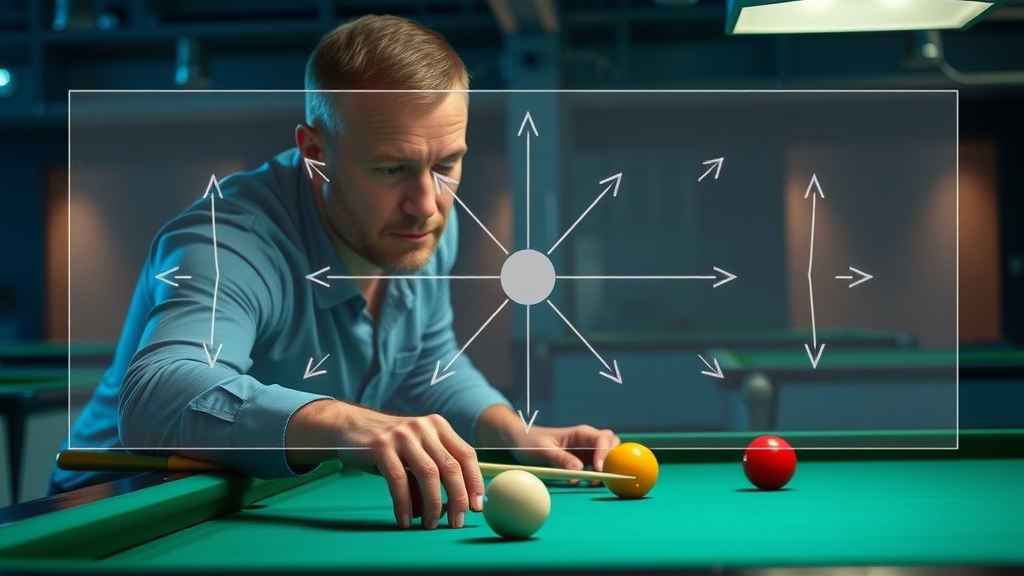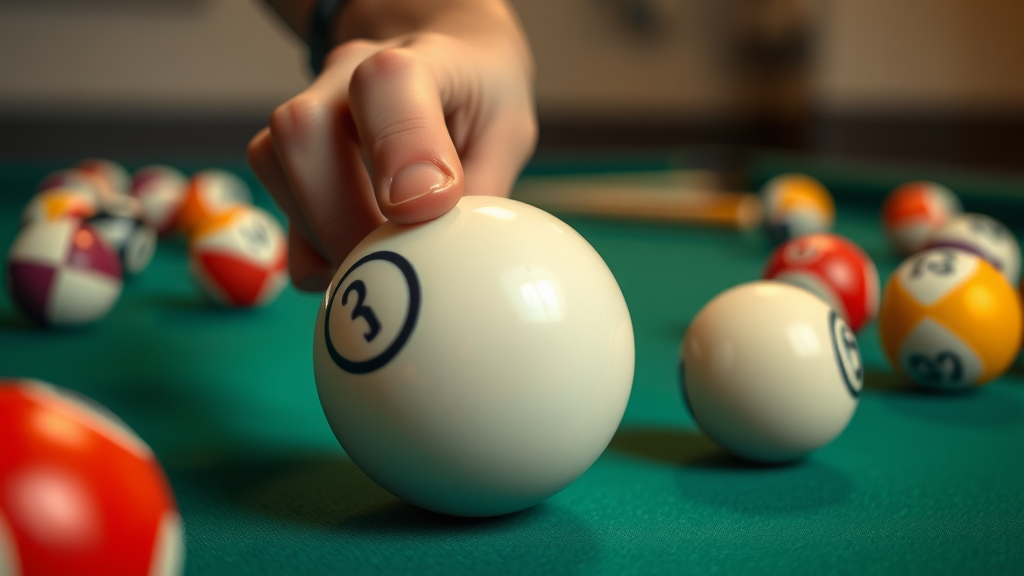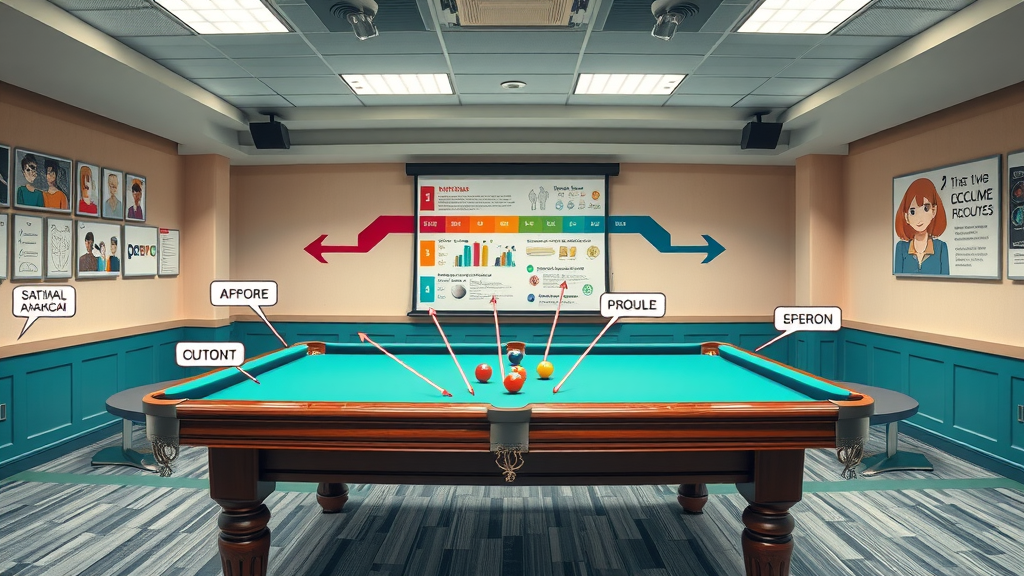Have you ever lost a close match due to an unexpected mistake, wondering how professionals transform defense into victory? Discover why mastering billiard safety play is the game-changer that separates seasoned players from casual ones. By elevating your understanding of safety play, you’ll not only raise your win rate but also avoid costly errors that can turn the tide in critical pool matches. Dive in as we uncover essential tips, strategic insights, and actionable techniques to ensure your next time to play is both safe and smart.

Are You Overlooking the Importance of Billiard Safety Play?
If you’re eager to improve at pool or billiards, focusing only on flashy pool shots often leads to missed opportunities and unexpected mistakes. The unsung hero of the game— billiard safety play —holds the key to controlling tough situations and shaping your strategy. Neglecting safety play can leave opponents with an open shot, setting you up to lose control of the table and possibly the game. Skilled competitors consistently keep the cue ball out of easy range, utilizing safety shots that make it frustrating and challenging for anyone going against them.
Consider this: every elite player, whether in 8-ball, 9-ball, or straight pool, knows when to play safe and when to strike for the win. By observing your table position and the potential for your opponent’s success, you can use safety play to limit their options—or even force them into a mistake. For example, if you’re left with a difficult shot near the rail, instead of risking a failed pot, you can opt for a tactical safety shot, placing the object ball away from pocket zones and the cue ball behind blockers. This approach not only keeps you in the game but also increases your chances to gain control in the next round. Ultimately, prioritizing billiard safety play transforms you into a versatile and intelligent pool player.
Discover how mastering billiard safety play can sharpen your skills and save you from expensive mistakes on the table.
- What safety play in billiards means and why it’s vital
- How to execute a perfect safety shot in pool
- Essential tips to play safe and outsmart your opponents
- Common rules and mistakes, like scratching or the 3 point rule in billiards
Billiard Safety Play Strategies: Mastering Safe and Tactical Decisions
Developing effective billiard safety play strategies is crucial for gaining an edge in competitive matches. A great tactical player knows when to play for position and when to shift into a defensive stance. Your ability to execute a solid safety shot or block crucial shots leads to increased control and fewer opportunities for your opponent. Often, players eager for flashy wins leave themselves exposed by ignoring these fundamentals. Practicing safeties during pool practice is just as important as refining your break or finishing the 8-ball.
Strategic billiard safety play relies on reading the table dynamics. Whenever the cue ball or an object ball lands in a tricky spot, it’s time to play safe—especially if the next shot appears low-percentage. By using clusters and rails, you can trap the cue ball, blocking your opponent from any direct pot or open shot. In the encyclopedia of pool shots, top safety plays are regarded as the backbone of smart, winning pool. This mindset will keep your competition guessing and often force them into errors, giving you “ball in hand” opportunities or an open table for your next shot.
Recognizing those key moments to play a safety rather than a risky offensive shot determines the outcome of many games. Analyze every situation for tactical value: sometimes, a defensive move—such as hiding the cue ball behind blockers or using two-way shots—offers far greater reward than attacking. The strongest players, from local club champions to professionals, constantly refine their safety play skills to outthink the opposition.
Understanding the Fundamentals of Safety Play in Billiards
Safety play in billiards means intentionally leaving your opponent with a difficult or nearly impossible shot. Rather than simply going for the next available object ball, the art is to ensure your opponent cannot make an easy shot or capitalize on a wide-open table. The cue ball becomes your main tool for “playing safe”—using angles, rail cushions, or clusters to block future paths to the pocket. This approach is essential for players aspiring to tournament success, as defense often dictates the flow of tight matches.
The most valuable advantage of playing safe is controlling the table’s rhythm. It prevents your opponent from running racks or stringing together high-percentage shots. By using a combination of cue ball control, object ball positioning, and table awareness, you essentially dictate your opponent’s options and force them into uncomfortable decisions. In professional settings, a well-executed safety play can even become demoralizing for opponents over time, tilting the mental game in your favor.
Opportunities for safety play are everywhere—but recognizing them requires practice and a keen eye. Look for scenarios where the next pool shot holds too much risk: for example, when the cue ball is near a cluster or the angle for potting the object ball is unfavorable. Instead of a rash shot, plan for a safety shot: gently tap the object ball while leaving the cue ball in a position that denies your opponent a clear line of attack.

- What is safety play and how it shapes your game’s outcome
- Key advantages of choosing to play safe
- Recognizing opportunities for a strategic safety shot
| Safety Tactic | Situation | Result |
|---|---|---|
| Standard Safety Shot | Obstructing opponent | Limited shot options |
| Two-way shot | Unclear advantage | Both offensive & defense |
| Cue ball hide | Open layout | Blocks next target ball |
"Great players win more games with safety play than with spectacular shots." – Pro Player Wisdom
How to Play Safe in Billiards: Practical Safety Shot Methods
Many pool enthusiasts focus on dazzling finishes, but true mastery comes with learning how to play safe . Practicing the mechanics of a solid safety shot in various contexts—8-ball, 9-ball, or straight pool—allows you to manage the cue ball with precision and block potential scoring routes for your rival. Think of it as a form of tactical chess, where every move positions you for long-term advantage rather than immediate rewards. Determining the right time to play safe can mean the difference between a narrow loss and a convincing win.
Every successful safety play begins by reading the table. Study object ball clusters, rail placements, and your own strengths at cue ball control. If you see no feasible shot at potting the next object ball, transition into defense: plan a shot that leaves the cue ball tucked behind blockers or lined up on the rail out of the open shot lane. The more you practice safety shots , the easier it becomes to identify defensive opportunities and leave the cue ball where it will pose the most difficulty for your opponent.
Mix offensive attempts and safety play for a well-rounded strategy. Avoid falling into the trap of always “going for broke”—instead, balance high-risk shots with defensive maneuvers that aggravate your opponent’s position. Incorporating these practical safety shot methods into your pool practice turns you from an average player into a match-winning tactician.

Step-by-Step Guide: Playing Safe and Effectively in Pool
- Assess your table position and opponent’s weaknesses.
- Identify lanes to hide the cue ball behind object balls.
- Use cue ball control to block straightforward shots.
- Aim for clusters or rails to reduce your opponent’s options.
- Always think two shots ahead to set up future safety play.
Video Tutorial: Executing the Perfect Billiard Safety Play Shot
While nothing rivals hands-on table experience, watching a video encyclopedia of pool practice and safety plays can accelerate your progress. Video breakdowns reveal the subtle mechanics—angle setup, power control, and shot follow-through—that separate a routine safety play from a match-altering one. Explore free resources and video encyclopedias of pool shots online to supplement your training. Whether you’re a beginner wanting to play pool for the first time or a league player aiming to sharpen your competitive edge, these tutorials demystify complex strategies and show your support for content creators.
The beauty of visual learning is that you can review scenarios multiple times, noting the cues professionals emphasize: hand and arm positioning, object ball targeting, and defensive patterns. Video tutorials also often come with commentary, explaining not just “how” but also “why” certain decisions are made. If you want to speed up your progress, set aside moments during your monthly donation to show appreciation for site commercial free platforms offering quality, ad-free lessons—and revisit the encyclopedia of pool practice regularly. Each viewing elevates your knowledge and makes practicing safeties a natural part of your billiards game.
Many players fail to fully grasp safety play until they break down successful plays frame by frame. Take notes on two-way shots, cue ball positioning, and defensive use of blockers as presented in these videos. Apply those learnings the next time you’re at the table—watch your performance and confidence soar as you become the player others fear when it’s time to play safe.
Essential Billiard Safety Play Rules: Scratching, 3 Point Rule, and More
Before you master billiard safety play , understanding the rules governing safety shots and potential fouls is non-negotiable. The most common error is scratching—where the cue ball is pocketed—resulting in loss of control or direct “ball in hand” advantages gifted to your opponent. To avoid blunders, review guidelines set by organizations such as the Billiard Congress of America and the WPA. Scratches can negate even the best-laid safety plans, so controlling your cue ball is paramount for effective, legal play.
Another critical rule involves the 3 point rule , predominantly seen in professional tournaments. This rule requires the cue ball, or object balls, to contact at least three cushions to keep the shot valid. The rule’s intent is to prevent overly defensive, “dead” play and encourage continuous skillful engagement. When executing a safety shot, always consider the angles and force to ensure at least three contacts where necessary, minimizing the risk of a foul.
To remain in the game, don’t just focus on offense. Be diligent about rule nuances linked to playing safe. Knowing precise moments when a safety shot is permitted without risking a foul—like in the presence of a “ball in the middle” cluster or during standoffs—is the mark of an advanced player. Adhering to legal play not only maximizes your chances but also builds your reputation for integrity and professionalism on the table.

What Happens If You Scratch During a Billiard Safety Play?
Scratching is a painful but common mistake in billiard safety play. When the cue ball accidentally falls into a pocket as you try to play a safety, the usual penalty is that your opponent receives “ball in hand.” This gives them the freedom to place the cue ball anywhere on the table for their next shot, creating a prime scoring opportunity. If you’re forced to leave the cue ball in a cluster or near a pocket, always double-check your angles and speed to minimize this costly oversight. Scratching not only wipes out a well-planned defensive setup but also hands momentum to your opponent, which can be difficult to reclaim.
Learning how to avoid scratching during safety play is as essential as knowing when to execute a safety in the first place. Some players opt for softer strokes and practice positioning that never leaves the cue ball in the middle or near risky pockets. Consistency here comes from repetition— practicing safeties and replaying key scenarios will develop your skill in keeping the cue ball in trouble-free zones. Over time, your ability to avoid fouls while playing safe will directly translate into more match wins, especially against aggressive competitors who rely on mistakes.
Finally, always review table and league rules regarding scratching. Some formats have stricter interpretations or offer unique penalties for fouls. Whether you’re competing or playing for fun, avoid leaving the cue ball in vulnerable positions and always aim the cue ball somewhere safe after every safety play.
Understanding the 3 Point Rule and Its Impact on Safety Play
The 3 point rule in billiards is designed to prevent overly defensive play and to guarantee continuous action throughout the game. Under this rule, when a player plays a shot—including a safety—at least three points of contact must occur, whether that’s cue ball to object ball to rails or a combination thereof. If the shot does not meet these requirements, it’s considered a foul, and the penalty often gives the opponent a strategic advantage. Mastering this rule is paramount for anyone interested in professional or tournament play, especially when leveraging safety plays to turn the tide of a close match.
When planning to play a safety and combine defensive positioning with legal shot execution, always map out how your cue ball or object ball will strike at least three rails. Incorporate this habit into your pool practice to avoid easy fouls and make sure your safety plays remain both effective and within the legal scope of the game. The rule adds complexity to tactical play—you can’t simply tap the cue ball into a cluster; you must ensure enough cushion contact to stay compliant. This dynamic not only protects against stalling tactics but also rewards skilled, thoughtful play that keeps the game moving and challenging.
The 3 point rule can profoundly impact your approach to billiard safety play. It encourages you to develop advanced strategic plans that account for table layout and potential cushion paths. Regularly practicing shots that meet the 3 point requirement will prepare you for high-stakes games and ensure that your defensive maneuvers are as powerful as your offensive ones. Use every practice session as an opportunity to merge creativity, discipline, and a deep understanding of billiard rules for a masterful, well-rounded game.
- Rule nuances to keep your safety play legal
- Common mistakes and how to avoid fouls
- Knowing when a safety shot is better than a risky pot
Video Breakdown: Rules Every Player Should Know About Billiard Safety Play
Sometimes, the best way to understand complex rules is through a detailed video breakdown. Tutorials that focus specifically on the rules governing billiard safety play—such as scratching, ball in hand, and the 3 point rule—will clarify tricky scenarios. Watch for iii of the video or iv of the video that explains “live” gameplay key moments. Learning visually helps cement best practices and corrects misconceptions that lead to lost frames.
Platforms and video encyclopedia resources often feature commercial free lessons dedicated to rules-based play. If you rely on donations to show your support for these sites, prioritize those that keep their site commercial free and regularly update with educational content. It’s a small gesture—but one that helps ensure a steady stream of high-quality material in the future for both beginner and advanced players. The more rules-savvy you become, the fewer donation to show moments you’ll need to explain after a controversial call.
Building your confidence in legal play means fewer costly errors. Repeatedly reviewing these video tutorials—especially those tailored to the encyclopedia of pool and the encyclopedia of eight ball —will keep you sharp, accurate, and respected on the table. When you have the rules ingrained, you can focus on strategic moves and enjoy each time to play without anxiety about unexpected fouls.
FAQs About Billiard Safety Play and How to Play Safe Effectively

People Also Ask: What is safety play in pool?
Answer: Safety play refers to a strategic approach in pool or billiards where the player deliberately positions the cue ball or object balls to make the next shot difficult for the opponent. This defensive maneuver is crucial for high-level play and is a hallmark of experienced competitors.
People Also Ask: How to play safe in an 8 ball pool?
Answer: To play safe in 8 ball pool, analyze the layout, choose to leave the cue ball behind obstruction balls, and avoid leaving the opponent with straightforward shots. Strategic use of clusters and rails increases your advantage.

People Also Ask: What are the rules for scratching in billiards?
Answer: Scratching—pocketing the cue ball—results in a penalty, usually gifting your opponent 'ball in hand' or another advantage. Follow formal rules to minimize costly scratches during safety play.
People Also Ask: What is the 3 point rule in billiards?
Answer: The 3 point rule, often used in certain billiard variants, requires a player to make the cue ball or object balls contact at least three cushions for the shot to count. This encourages skillful and controlled play, especially during safety play situations.
Elevate Your Game: Adopt Proven Billiard Safety Play Strategies Today
Take advantage of professional safety play tactics to outsmart your competition. Practice disciplined safety shots, observe the rules, and never underestimate the power of playing safe in billiards to consistently win and avoid errors.
Take action: Next time you play pool, adopt these safety strategies, refine your shot selection, and make disciplined safety play a foundation of your game to build consistent, winning performance.
 Add Row
Add Row  Add
Add 


Write A Comment